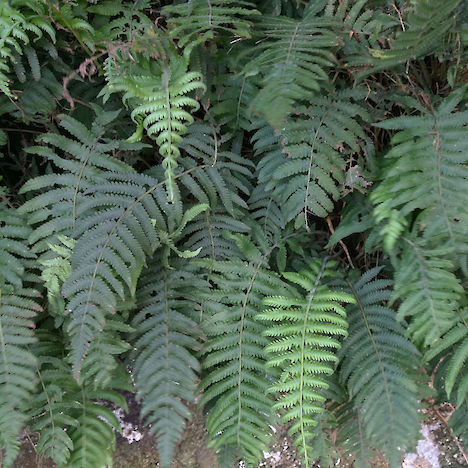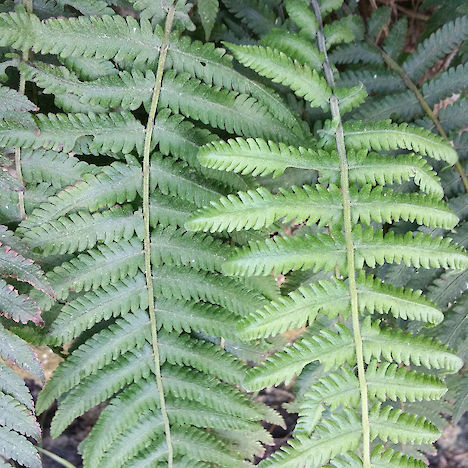Other names:
Soft fernThreat category:
Multiple?Regions:
Northland, Waikato, Bay of PlentyDistribution:
Taupo Volcanic Zone and Northland
Overview of the species complex
- At the current time, the taxonomy of the Christella dentata species complex in New Zealand is somewhat contentious. The overall history of the taxonomy in New Zealand is summarised in Brownsey and Perry (2016). Allen (1961) recognised only a single species of Christella in New Zealand as Thelypteris dentata. Given (1981) suggested that plants from geothermal areas may be different from plants occurring in Northland. Various publications since then (e.g. Brownsey et al. 1985, Brownsey & Smith Dodsworth 1989, and de Lange 2010) have recognised two taxa of Christella present in New Zealand, although Brownsey and Perrie (2016a &b) recognise only one variable species present in New Zealand, with similar variation to the species present in Australia. To complicate matters, some forms of Christella in New Zealand have probably been introduced; however the populations occurring in geothermal are considered naturally occurring.
- The plants found in geothermal sites in New Zealand were referred to as Christella aff. dentata (b) (AK 126902; “thermal”), while the plants naturally occurring near Kaitaia and Te Paki as Christella dentata (Forssk.) Brownsey & Jermy in de Lange et al. (2018). Both taxa ‑ if they are in reality different ‑ are considered to occur widely outside New Zealand.
Threat Status
- The conservation status of Christella aff. dentata (b) (AK 126902; “thermal”) was assessed as ‘Threatened-Nationally Endangered, while Christella dentata (Forssk.) Brownsey & Jermy was assessed as At Risk-Naturally Uncommon (de Lange et al. 2018).
Key Features
- Christella dentata is a terrestrial fern recognised by its herbaceous fronds, with primary pinnae divided ⅓ to ¼ to the midrib with obtuse truncate segments, the basal pair of pinnae reduced, veins in adjacent segments joining, indumentum on the abaxial surfaces comprising acicular hairs and tiny capitate hairs lacking scales, and indusia acicular hairs (Brownsey and Perrie 2016b).
- It can be separated in the field from Cyclosorus interruptus and Thelypteris confluens by its creeping rhizomes up to 1 metre long (de Lange, iNaturalist NZ # 1463496), erect fronds (up to 1 meter tall (de Lange, AK 314009), and fronds arising in tufts at apices, with short distances between adjacent stipes; whereas the other two species have longer-creeping rhizomes and more widely spaced fronds (Brownsey and Perrie 2016b).
Distribution and Habitat
- Within New Zealand, Christella dentata has not been recorded south of the volcanic plateau. In the North Island, most natural populations are present in geothermal habitats within the Taupo Volcanic Zone between Rotorua and Tokaanu, at elevations of up to 400 metres above sea level near Taupo. It has also been recorded from lowland sites in Northland at Te Paki and near Kaitaia. Other populations from the Waikato (e.g. Kawhia, near Piopio, Hamilton), and in Auckland City may be escapes of New Zealand sourced plantings or introduced plants of garden origin. It is also known from the Kermadec Islands, and is widely distributed in the tropics and subtropics from Africa to India, Asia, Australia and many Pacific Islands and elsewhere (Brownsey and Perrie 2016b).
- In geothermal areas, this species mostly present near geothermal springs and riparian stream margins in areas that are locally heated by steam produced by these features. Most sites where it occurs are also sheltered by other vegetation which protects the species from cold conditions. It is known from 15 sites in the Taupo Volcanic Zone, but several of these sites have very small population sizes and are highly vulnerable to extinction.
- In Northland, Christella dentata is mostly found in disturbed, cattle trampled sites, in coastal wetlands, river banks, stream banks, along roadsides, in drains, under rawiri (Kunzea linearis) forest and in alluvial podocarp forest (Brownsey and Perrie 2016b).
Threats
- Key threats in geothermal areas are its vulnerability to browsing and grazing by stock, vegetation clearance, and loss of activity due to depletion of geothermal resource for other uses e.g. energy extraction. Clearance of protective cover can make plants vulnerable to cold winter conditions and kill plants. Many small populations are vulnerable to small local events such high river flows, slips and other local events. Plants are vulnerable to establishment of weeds such as blackberry. Plants can establish well after disturbance if suitable habitats are present in areas with an existing population.
- Plants in Northland are vulnerable to natural succession and rank growth of weeds following fencing of the forest remnants it is known from (de Lange et al. 2010).
- Many populations are very small in size, particularly in the Taupo Volcanic Zone, and are therefore vulnerable to extinction.
Management Opportunities
- Survey for new locations.
- Record known sites.
- Prepare a management plan for each population. Management may vary from controlling weeds, creating small disturbed areas of suitable habitat, fencing to exclude stock, and maintain cover at sites vulnerable to cold conditions particularly in winter.
- Protect habitat.
- Ensure that forest owners are aware of potential habitats and can recognise the species.
Monitoring Options
- Check existing populations annually as population sizes can vary markedly from year-to-year. Record the population size and monitor population demographics (size, growth, density, distribution) over time.
- Report new locations to DOC.
- Further Information and Support
- Weed control - Department of Conservation, Regional Councils.
References
- Brownsey P.J., Given D.R. & Lovis J.D. 1985: A revised classification of New Zealand pteridophytes with a synomatic checklist of New Zealand species. New Zealand Journal of Botany 23(3): 431-489.
- Brownsey P.J. & Jermy, A.C. 1973: A fern collecting expedition to Crete. British Fern Gazette 10:10-31.
- Brownsey P.J. & Smith-Dodsworth J.C. 2000: New Zealand Ferns and Allied Plants. David Bateman, Auckland.
- Brownsey P.J. & Perrie L.R. 2016a: Re-evaluation of the taxonomic status of Christella dentata (Thelypteridaceae) supports one species in New Zealand. Tuhinga 27:49-54.
- Brownsey P.J. & Perrie L.R. 2016b: Thelypteridaceae. In: Breitwieser I.; Wilton A.D. Flora of New Zealand ferns – Fern and Lycophytes. Fascale 16. Manaaki Whenua Press, Lincoln..
- de Lange 2010: Fact sheet prepared for NZPCN by P.J. de Lange (12 October 2003). Description modified from de Lange et al. (2010). New Zealand Plant Conservation Network (NZPCN). http://www.nzpcn.org.nz/flora_details.aspx?ID=12: Accessed 5 March 2019.
- de Lange P.J., Heenan P.B., Norton D.A., Rolfe J.R., and Sawyer J.W.D. 2010: Threatened Plants of New Zealand. Christchurch, Canterbury University Press. 471 pp.
- de Lange P.J., Rolfe J.R., Barkla J.W., Courtney S.P., Champion P.D., Perrie L.R., Beadel S.M., Ford K.A., Breitwieser I., Schönberger I., Hindmarsh-Walls R., Heenan P.B. and Ladley K. 2018: Conservation status of New Zealand indigenous vascular plants, 2017. New Zealand Threat Classification Series 22. Department of Conservation, Wellington. 82 pp.




